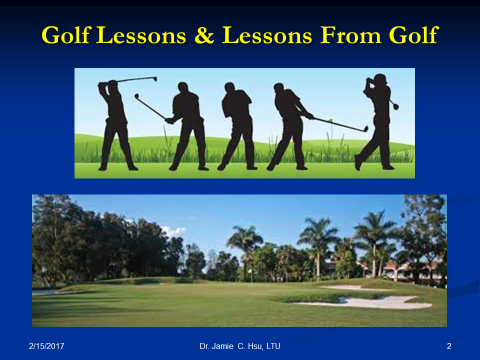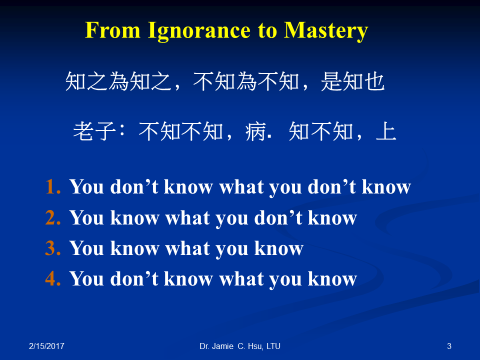
Golf Lessons and Lessons from Golf
– Musings by Dr. Jamie Hsu, 3.9.2017
When I first started to learn golf, I thought it should be easy compared to tennis and other ball games. The golf ball just sits there waiting for me to hit it, and I have no opponent trying to beat me. Was I wrong! I was at the stage of “I don’t know what I don’t know.”
As I more seriously began to practice on the driving range, I suddenly found the balls I hit would spread all over the place. Some balls went left, some went right, some would roll on the ground, and occasionally a few did manage to fly straight. Now I entered the stage of “I know what I don’t know.”
With the help of some golf instruction books, videos, and lessons from the pros, I began to know that I need to keep my head still, hold my arm straight, maintain the spine angle, and turn my hip toward the target. After thousands and thousands of balls, and rounds and rounds of golfing on the courses, I memorized all the correct moves and sequences. Now “I know what I know.”
Fast forward 20 years and I am still struggling with the golf game. The pros told me that if I want to play well, I need to have “the rhythm, the feeling, and the tempo.” What they try to teach me is not easily describable. The pros are in the stage of “I don’t know what I know.” For me, this mastery of the golf game might be just beyond my reach.
In our lives, we can all relate to these 4 stages of progression in the skills we try to learn or to teach. The most important thing is to get out of the first stage of “ignorance” and recognize the need to learn. With practices and good teachers, we can progress to identifying what we don’t know and learning what we need to know.
Eventually, after cycles of practice, reflection, and self-analysis, we’ll be able to integrate all the necessary skills into a holistic approach. That is the time we may enjoy the feeling of “things just happen naturally without much effort” — that elusive pleasure of true mastery.


小白球的啟發
-作者 許俊宸博士
-中譯 薛乃綺
我開始學打高爾夫球的時候,我以為它應該會比網球或其他球類要來得簡單。因為這些小白球就安安靜靜地在定點上等著我去打,並沒有其他的競爭者會來乱局。我實在大錯特錯!那時候的我停留在那“我不知道我所不知道的” 階段。
當我開始更認真地在球場練球後,我赫然發現我打的球總是在整個球場中亂飛。有跑左邊的、有跑右邊的、有些則滾在地上,偶爾還會有幾個設法往前直飛的。這時候的我才進入到“我知道我有所不知道的”階段。
在一些高爾夫球教學書籍、影片、專家訓練課程的影響下,我才知道打球時,我需要讓頭部穩定、手臂打直、維持仰角、並且將臀部转向目標。在打擊了成千上萬個小白球、以及好幾輪的高球課程後,我記住了這些正確的動作與順序。這個時候我到了“我知道我所知道的”階段。
20個年頭飛快過去了,我現在還在高爾夫球比賽场中持續努力。專家告訴我,如果我想打得一手好球,我需要有“韻律、感覺和節奏”。但專家們試圖表達的東西實在不好琢磨。可以說,專家處於“我不知道我所知道的”階段;對我而言,要征服這樣的高爾夫球,恐怕是我很難達到的境界。
在我們的生活中,每個人對於想學習或想傳授的技能上,都可能經歷這四個階段。更重要的是,要走出‘不知無知’的階段,去認知學習的需要。跟實務經驗熟稔的好老師學習,我們才可以進步、了解我們所不知道的、並且學習我們需要知道的。
最終,經過幾個循環的練習、反思、自我分析後,我們就能夠將所有必要的技巧整合成一個全方位的途徑。那個時候的我們,或許就能夠享受”自然而然、水到渠成”的感覺了!


